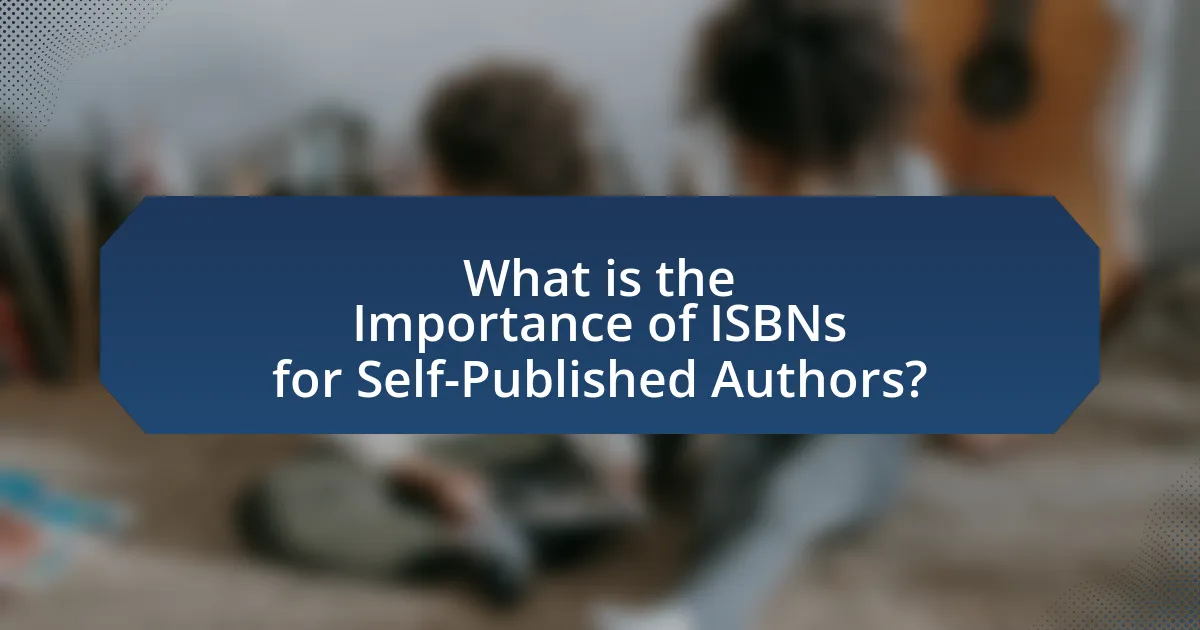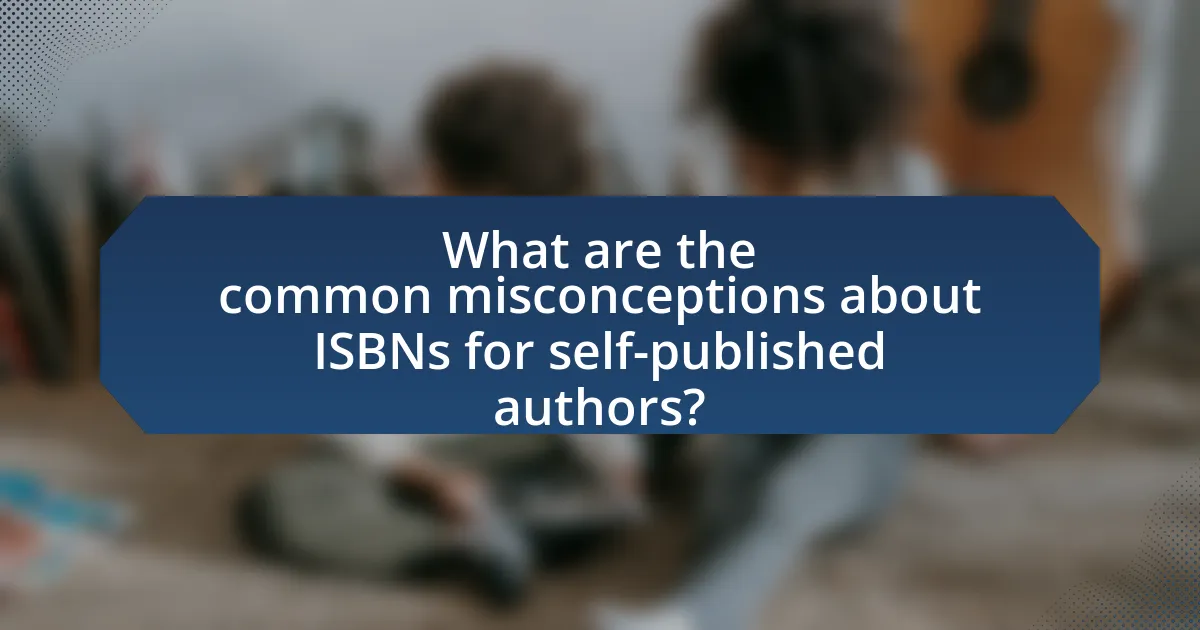The article focuses on the significance of International Standard Book Numbers (ISBNs) for self-published authors. It outlines how ISBNs serve as unique identifiers that enhance book distribution, sales tracking, and credibility in the marketplace. Key components of an ISBN, its structure, and the differences between ISBNs for print and digital formats are discussed. Additionally, the article addresses common misconceptions about ISBNs, best practices for obtaining and using them, and their impact on marketing and visibility in libraries and retail environments. Overall, the article emphasizes the essential role ISBNs play in the success of self-published works.

What is the Importance of ISBNs for Self-Published Authors?
ISBNs are crucial for self-published authors as they provide a unique identifier for their books, facilitating easier distribution and sales tracking. This unique identifier helps retailers, libraries, and readers locate and purchase the book efficiently. Additionally, having an ISBN enhances the book’s credibility and professionalism, making it more appealing to potential buyers. According to Bowker, the official ISBN agency in the United States, books with an ISBN are more likely to be stocked by retailers and libraries, which can significantly increase sales opportunities for self-published authors.
Why do self-published authors need ISBNs?
Self-published authors need ISBNs to ensure their books are uniquely identified and easily discoverable in the marketplace. An ISBN, or International Standard Book Number, provides a standardized identifier that helps retailers, libraries, and distributors manage inventory and sales. Without an ISBN, a book may struggle to gain visibility and credibility, as it cannot be easily cataloged or tracked by major retailers and online platforms. Furthermore, having an ISBN allows authors to establish ownership and control over their work, facilitating better distribution options and sales reporting.
What role does an ISBN play in book distribution?
An ISBN (International Standard Book Number) is crucial for book distribution as it uniquely identifies a book, facilitating its tracking and sales across various platforms. This unique identifier allows retailers, libraries, and distributors to efficiently manage inventory and sales data. According to Bowker, the official ISBN agency in the United States, over 80% of books sold in the U.S. are assigned an ISBN, underscoring its significance in the marketplace. Without an ISBN, a book may struggle to gain visibility and accessibility in retail and library systems, limiting its distribution potential.
How does an ISBN enhance a book’s credibility?
An ISBN enhances a book’s credibility by providing a unique identifier that distinguishes it from other publications. This unique number allows booksellers, libraries, and readers to easily locate and reference the specific title, thereby establishing a professional standard in the publishing industry. Furthermore, the presence of an ISBN signals to consumers that the book has undergone a formal publishing process, which often includes editorial review and quality control, reinforcing the author’s legitimacy. According to Bowker, the official ISBN agency in the United States, books with ISBNs are more likely to be stocked by retailers and libraries, further validating their credibility in the marketplace.
What are the key components of an ISBN?
The key components of an ISBN (International Standard Book Number) are the prefix element, registration group element, registrant element, publication element, and check digit. The prefix element, typically “978” or “979,” identifies the book industry, while the registration group element indicates the country or language group. The registrant element identifies the specific publisher, and the publication element specifies the individual title or edition. Finally, the check digit is a single digit that validates the number’s accuracy through a mathematical formula. Each component plays a crucial role in ensuring that books are uniquely identified and easily cataloged in databases worldwide.
What information is encoded in an ISBN?
An ISBN encodes specific information about a book, including the title, author, edition, publisher, and format. The structure of an ISBN consists of a unique identifier that allows for the efficient cataloging and distribution of books. Each ISBN is divided into parts: the prefix element, registration group element, registrant element, publication element, and check digit, which collectively ensure that each book can be distinctly identified in the marketplace. This system is crucial for self-published authors as it facilitates sales tracking and inventory management, making their works easily discoverable by retailers and libraries.
How does the structure of an ISBN work?
The structure of an ISBN (International Standard Book Number) consists of 13 digits, which are divided into five parts: the prefix element, the registration group, the registrant element, the publication element, and the check digit. The prefix element, typically “978” or “979,” identifies the book industry, while the registration group identifies the country or language area. The registrant element specifies the publisher, and the publication element identifies the specific title or edition. Finally, the check digit is used to validate the number’s accuracy through a mathematical formula. This structured format ensures that each book can be uniquely identified, facilitating distribution and sales tracking in the publishing industry.
What are the different types of ISBNs available?
There are three different types of ISBNs available: ISBN-10, ISBN-13, and ISBN for specific formats. ISBN-10, which consists of 10 digits, was used until 2007, while ISBN-13, introduced in 2007, consists of 13 digits and is now the standard format. Additionally, there are specific ISBNs for different formats such as eBooks, audiobooks, and print editions, allowing each version of a title to be uniquely identified. The transition from ISBN-10 to ISBN-13 was made to accommodate the growing number of publications and to ensure compatibility with the global EAN system.
How do ISBNs differ for print and digital formats?
ISBNs for print and digital formats differ primarily in their allocation and usage; each format requires a unique ISBN. Print books typically use a 13-digit ISBN that identifies the specific edition and format, while digital formats, such as eBooks, also require a separate 13-digit ISBN to distinguish them from their print counterparts. This differentiation is crucial for inventory management, sales tracking, and distribution, as each ISBN serves as a unique identifier in databases and retail systems. According to the International ISBN Agency, having distinct ISBNs for each format ensures that books are accurately cataloged and sold, facilitating easier access for consumers and retailers alike.
What is the significance of a 13-digit ISBN?
A 13-digit ISBN is significant because it uniquely identifies a specific edition of a book, facilitating its distribution and sales tracking. The transition from a 10-digit to a 13-digit format in 2007 was made to accommodate the growing number of publications and to align with the EAN-13 barcode standard used globally in retail. This change enhances the ability of booksellers, libraries, and distributors to manage inventory and sales more efficiently, ensuring that each book can be accurately located and purchased. The 13-digit ISBN system also supports international trade by providing a standardized identification method across different countries and languages.

How do ISBNs affect the marketing of self-published books?
ISBNs significantly enhance the marketing of self-published books by providing a unique identifier that facilitates distribution and sales tracking. This unique identifier allows retailers, libraries, and online platforms to catalog and sell the book efficiently, increasing its visibility in the marketplace. Furthermore, having an ISBN lends credibility to the self-published work, as it signals professionalism and adherence to industry standards. According to Bowker, the official ISBN agency in the United States, books with ISBNs are more likely to be stocked by retailers and libraries, which can lead to increased sales opportunities. Thus, ISBNs play a crucial role in the marketing strategy of self-published authors by improving discoverability and establishing legitimacy.
What marketing advantages do ISBNs provide?
ISBNs provide significant marketing advantages by enhancing a book’s visibility and accessibility in the marketplace. They enable efficient cataloging and distribution across various platforms, making it easier for retailers and libraries to locate and order the book. Furthermore, ISBNs facilitate tracking sales data and inventory management, which is crucial for self-published authors aiming to analyze their market performance. According to Bowker, the official ISBN agency in the United States, books with ISBNs are more likely to be stocked by retailers and libraries, thereby increasing potential sales opportunities.
How can an ISBN improve visibility in online bookstores?
An ISBN improves visibility in online bookstores by providing a unique identifier for each book, which facilitates easier cataloging and searching. This unique identifier allows online retailers and libraries to accurately list and manage inventory, making it simpler for potential readers to find the book. According to Bowker, the official ISBN agency in the United States, books with an ISBN are more likely to be stocked by retailers and libraries, as they can be easily tracked and ordered. Additionally, having an ISBN enhances the book’s credibility and professionalism, which can attract more attention from both consumers and retailers.
What impact does an ISBN have on sales tracking?
An ISBN significantly enhances sales tracking by providing a unique identifier for each book, which facilitates accurate inventory management and sales reporting. This unique code allows retailers, distributors, and libraries to efficiently track sales data across various platforms, ensuring that sales figures are accurately recorded and reported. According to Bowker, the official ISBN agency in the United States, books with an ISBN are more likely to be stocked by retailers and libraries, leading to increased visibility and sales opportunities. Furthermore, sales tracking systems rely on ISBNs to aggregate data, enabling authors and publishers to analyze sales trends and make informed marketing decisions.
How do ISBNs facilitate library and retailer access?
ISBNs facilitate library and retailer access by providing a unique identifier for each book, which simplifies the cataloging and inventory processes. Libraries and retailers use ISBNs to efficiently track, order, and manage books within their systems, ensuring accurate records and streamlined access for patrons. The International Standard Book Number system, established in 1970, assigns a distinct 13-digit code to each edition of a book, allowing for precise identification and reducing the likelihood of errors in ordering and stocking. This system enhances discoverability and accessibility, as libraries and retailers can quickly locate specific titles using their ISBNs, ultimately benefiting both the institutions and the readers they serve.
Why are ISBNs essential for library cataloging?
ISBNs are essential for library cataloging because they provide a unique identifier for each book, facilitating accurate tracking and organization within library systems. This unique identification helps libraries manage their collections efficiently, ensuring that patrons can easily locate specific titles. According to the International ISBN Agency, the use of ISBNs streamlines the cataloging process, reduces errors in book identification, and enhances the interoperability of library databases. By assigning a distinct ISBN to each edition and format of a book, libraries can maintain precise records and improve the overall user experience in accessing literature.
How do retailers use ISBNs to manage inventory?
Retailers use ISBNs to manage inventory by assigning a unique identifier to each book, which facilitates tracking, ordering, and sales analysis. This system allows retailers to efficiently organize their stock, ensuring that they can quickly locate specific titles and monitor inventory levels. For instance, when a retailer scans an ISBN at the point of sale, it automatically updates the inventory system, reflecting the sale and helping to manage restocking needs. Additionally, ISBNs enable retailers to analyze sales data by title, author, or genre, providing insights into customer preferences and inventory turnover rates. This structured approach to inventory management is essential for maintaining optimal stock levels and meeting consumer demand.

What are the common misconceptions about ISBNs for self-published authors?
Common misconceptions about ISBNs for self-published authors include the belief that an ISBN is not necessary for digital books, that self-publishing platforms automatically provide an ISBN, and that purchasing an ISBN from a third party is always more beneficial than obtaining one directly from the official ISBN agency. Many authors mistakenly think that digital formats do not require an ISBN, but most retailers and libraries prefer or require them for cataloging. Additionally, while some platforms do offer free ISBNs, these may limit the author’s control over their book’s rights and distribution. Lastly, purchasing an ISBN from a third party can lead to complications regarding ownership and rights, as the ISBN is often registered under the third party’s name rather than the author’s.
What myths exist regarding the necessity of ISBNs?
One prevalent myth regarding the necessity of ISBNs is that they are mandatory for all published books. In reality, while ISBNs enhance distribution and sales tracking, they are not legally required to publish a book. Many self-published authors choose to publish without an ISBN, especially when using platforms that do not require one, such as certain e-book services. Additionally, another myth is that obtaining an ISBN guarantees better sales; however, sales success is influenced more by marketing strategies and audience engagement than by the presence of an ISBN.
Is it possible to publish without an ISBN?
Yes, it is possible to publish without an ISBN. Many self-publishing platforms allow authors to publish their works without requiring an ISBN, as they may provide their own identification numbers for distribution. For instance, Amazon Kindle Direct Publishing (KDP) enables authors to publish eBooks without an ISBN, assigning an ASIN instead. This approach is common among independent authors who may choose to forgo the ISBN to simplify the publishing process.
Do self-published authors have to purchase their own ISBNs?
Self-published authors typically have to purchase their own ISBNs. While some self-publishing platforms offer free ISBNs, these are often limited in terms of ownership and distribution rights. For instance, if an author uses a platform like Amazon Kindle Direct Publishing, they can obtain a free ISBN, but the platform retains certain rights over the book’s publication. In contrast, purchasing an ISBN from an official agency, such as Bowker in the United States, grants the author full control and ownership, allowing for broader distribution options and the ability to publish under their own name.
What are the best practices for obtaining and using ISBNs?
The best practices for obtaining and using ISBNs include registering with an official ISBN agency, ensuring each format of a book has a unique ISBN, and maintaining accurate metadata. Authors should obtain their ISBNs from the official agency in their country, such as Bowker in the United States, to ensure legitimacy. Each version of a book, whether print, e-book, or audiobook, requires a separate ISBN to facilitate proper cataloging and sales tracking. Accurate metadata, including title, author, and publisher information, is crucial as it enhances discoverability and sales potential. Following these practices ensures that self-published authors can effectively manage their publications and reach their target audience.
How can authors ensure they are purchasing legitimate ISBNs?
Authors can ensure they are purchasing legitimate ISBNs by acquiring them directly from the official ISBN agency in their country. Each country has a designated agency responsible for issuing ISBNs, such as Bowker in the United States and Nielsen in the United Kingdom. Purchasing from these official sources guarantees that the ISBNs are valid and properly registered, preventing issues with distribution and sales. Additionally, authors should avoid third-party sellers or websites that claim to sell ISBNs at a discount, as these may provide invalid or duplicate numbers, leading to complications in the publishing process.
What steps should authors take after obtaining an ISBN?
After obtaining an ISBN, authors should register their book with the ISBN agency to ensure proper cataloging and distribution. This registration allows the book to be listed in databases used by retailers and libraries, increasing its visibility. Authors should also assign the ISBN to the specific format of their book, whether it is print, eBook, or audiobook, as each format requires a unique ISBN. Additionally, authors must include the ISBN in the book’s metadata and on the copyright page to facilitate sales tracking and inventory management. Properly utilizing the ISBN enhances the book’s marketability and accessibility in the publishing industry.





